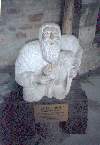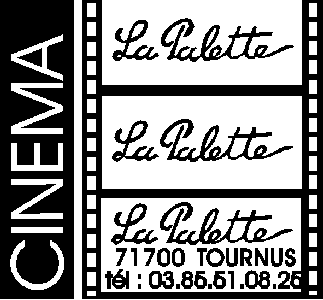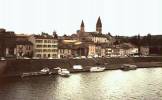The fine arts in Tournus
Painting:
One can't talk about painting in Tournus without mentioning Greuze (Tournus, 1725 - Paris, 1805). The town may be proud being the birthplace of this painter and engraver recognised in the whole world. The municipal museum is named Greuze Museum. It owns many drawings from him (wash paintings, red chalk drawings...) and more, several authentic paintings. Many other Greuze's paintings can be seen in important international museums such as Montpellier, The Louvre and The British Museum.
For more information about Greuze, you can read the text (in French) by Marie LAPALUS "Jean-Baptiste Greuze, Peintre moralisant" in Bulletin municipal n° 29 (February 1992 - kept in the municipal library).
Graphic arts are still very living and most of the artists are members of the Association of Artists and Art Amateurs of Tournus (usually named as "the 3AT"). This association organises each year a Spring Exhibition to allow local artists showing their works with other amateurs and even some professionals. The association stands place Carnot, in the Town Centre.
Several art galleries are standing in the surroundings of the Abbey.
Sculpture:
 There's no doubt the more known of the sculptors in Tournus is Désiré Mathivet (end of XIXth / beginning of XXth c.) but young artists are proud to take inspiration in his style.
There's no doubt the more known of the sculptors in Tournus is Désiré Mathivet (end of XIXth / beginning of XXth c.) but young artists are proud to take inspiration in his style.
One may visit a professional artist's workshop, Bernard HUSSON, at Plottes.
Moreover, some amateur sculptors are members of the "3AT".
Music:
Even if he is not very famous, Monsieur de SAINTE COLOMBE, compositor and music teacher in the end of the XVIIth c., composed some works gathered in a "Manuscrit de Viole de Gambe" ("Manuscript of Viola" - viola is the ancestor of our cello) that was found in the first half of the 1990's in the Municipal Library. He was Marin MARAIS's teacher, central character in the Alain CORNEAU's film "Tous les Matins du Monde" ("All the Mornings of the World"). Also named "Manuscrit de Tournus", this manuscript is an important document for historians who have very few documents about music in those times.
Recently renewed, the organ that was built in 1629 is played during marvellous concerts given in the Abbey by great virtuosos and by the regular organist, Gérard GOUDET.
Alfred CORTOT's name (pianist, 1877-1962) is intimately tied to Tournus.
The compositor Edgar VARESE (1883-1965) declared he had found his musical inspiration in the Abbey of Tournus, which he used to visit when he was spending holidays in the close village Le Villars.
The Festival TOURNUS PASSIONS, since 1988, is an opportunity for high level concerts in the prestigious Abbey: for more than 10 years, the violinist Ivry GITLIS was the guest of the festival. In the same time, he gave lessons to young and talented musicians (his pupils came from the whole world and some of them were already famous professional musicians).
There are two amateur choirs (the "Baladins du Tournugeois" and the "Chorale de Tournus").
Jazz is honoured too; the association "Jazz en herbe" organizes each year a training course in Tournus (or in a village in the area) for young musicians. Another session of the training course is also organised in the smaller town Pont de Vaux, not far from Tournus.
A tenth or more of amateur groups are also performing pop music, reggae, electronic music...
The Municipal Music School allows children and adolescents to discover playing an instrument of their choice with very good teachers.
Literature:
Tournus is the birthplace of Albert THIBAUDET (Tournus 1874 - Geneva 1936). Teacher (colleges, University of Geneva), author of many books, this literary critic was really well known between the two World Wars. He gave in heritage to the Town the building of the Musée Perrin de Puycousin known as Burgondish Museum.
Poetry is a living art through Pascale BARRAUD and Marie-Odile GOUDET who read their texts during public lectures. In 2004, Marie-Odile GOUDET wrote her first novel.
Cinema:

The municipal cinema "La Palette" is a perpetually moving place: scholar projections, popular films and art films, thematic evenings organised by the dynamic director or by the association CINEMASCOTTE attract about 25,000 people each year.
Prestigious films are shown in national exclusivity (for example, "Lucie Aubrac" in which a scene was performed around the Abbey a few months earlier).
For several years, the "Rencontres Cinéma Droits de l'Homme" (Cinema and Human Rights Meeting) were a good mean to discover or re-discover films that are too often kept in the closed circuit of art films.
Architecture:
For millions of people all over the world, the name Tournus is tied to Romanesque art and to the Saint Philibert Abbey. Built in the last years of the Xth c. the church of the Abbey is remarkable by its original nave: very high in comparison to its surface and covered by a vault made of transverse cradles (we have not many other examples of such roofs).
However, the fame of the Abbey must not hide the interest of other churches in the town (Saint Valérien and Sainte Madeleine) nor civil architecture.
Not only the Romanesque architecture but life and medieval culture are the centre of very serious scientific studies published by the Centre International d'Etudes Romanes (C.I.E.R. - International Centre for Romanesque Studies) which was founded in Tournus in 1953).
|
Many Romanesque houses still stand in the Town Centre. One of them, rue de l'Hôpital (Hospital Street), after it was used as public baths, has been rebuilt and is now the entrance of the Hospital Museum installed in the Hôtel Dieu (Charity Hospital). |
Since July 1st, 1999, after 11 years spent in rebuilding and transformation works, the Hôtel Dieu (built in the XVIIth c. and extended until the end of the XVIIIth c.) is a serious challenger to its neighbours of Beaune and Louhans. The ceiling in the chemistry, the furniture in this room and in the sick persons' rooms must be looked with a lot of attention. |
Other interesting examples of civil architecture in the times the Hôtel Dieu was built can be seen in many other parts of the town but they are private properties and it is difficult to visit these. As in the old Lyon, lobbies (called "traboules" - private too -) often allow people to go from one street to another one trough a building.
Very narrow streets, souvenirs of medieval times, allow walkers to wander as if they were very far of the traffic. As in the main streets, some houses present very interesting details on their front.
The page "Visit Tournus" also evokes other aspects of architecture in Tournus.
